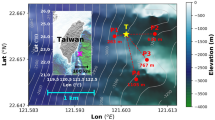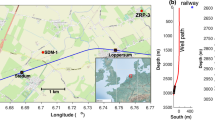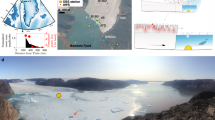Abstract
The subduction zone off the west coast of South America marks the convergence of the oceanic Nazca plate and the continental South America plate. Nazca–South America convergence over the past 23 million years has created the 6-km-deep Peru–Chile trench, 150 km offshore. High pressure between the plates creates a locked zone, leading to deformation of the overriding plate. The surface area of this locked zone is thought to control the magnitude of co-seismic release and is limited by pressure, temperature, sediment type and fluid content1. Here we present seafloor deformation data from the submerged South America plate obtained from a combination of Global Positioning System (GPS) receivers and acoustic transponders. We estimate that the measured horizontal surface motion perpendicular to the trench is consistent with a model having no slip along the thrust fault between 2 and 40 km depth. A tsunami in 1996, 200 km north of our site, was interpreted as being the result of an anomalously shallow interplate earthquake2. Seismic coupling at shallow depths, such as we observe, may explain why co-seismic events in the Peruvian subduction zone create large tsunamis.
This is a preview of subscription content, access via your institution
Access options
Subscribe to this journal
Receive 51 print issues and online access
$199.00 per year
only $3.90 per issue
Buy this article
- Purchase on Springer Link
- Instant access to full article PDF
Prices may be subject to local taxes which are calculated during checkout



Similar content being viewed by others
References
Tichelaar, B. W. & Ruff, L. J. Depth of seismic coupling along subduction zones. J. Geophys. Res. 98, 2017–2037 (1993)
Satake, K. & Tanioka, Y. Sources of tsunami and tsunamigenic earthquakes in subduction zones. Pure Appl. Geophys. 154, 467–483 (1999)
Cahill, T. & Isacks, I. Seismicity and shape of the subducted Nazca Plate. J. Geophys. Res. 97, 17503–17529 (1992)
Gutscher, M. Andean subduction styles and their effect on thermal structure and interplate coupling. J. S. Am. Earth Sci. 15, 3–10 (2002)
Moore, J. C. & Saffer, D. Updip limit of the seismogenic zone beneath the accretionary prism of southwest Japan: An effect of diagenetic to low-grade metamorphic processes and increasing effective stress. Geology 29, 183–186 (2001)
Oleskevich, D. A., Hyndman, R. D. & Wang, K. The updip and downdip limits to great subduction earthquakes: Thermal and structural models of Cascadia, South Alaska, SW Japan, and Chile. J. Geophys. Res. 104, 14965–14991 (1999)
Norabuena, E., Dixon, T. H., Stein, S. & Harrison, C. G. A. Decelerating Nazca–South America and Nazca–Pacific Plate motions. Geophys. Res. Lett. 26, 3405–3408 (1999)
Norabuena, E. et al. Space geodetic observations of Nazca–South America convergence across the central Andes. Science 279, 358–362 (1998)
Newman, A. V. et al. Along-strike variability in the seismogenic zone below Nicoya Peninsula, Costa Rica. Geophys. Res. Lett. 29, 38–41 (2002)
Chadwell, C. D. & Bock, Y. Direct estimation of absolute precipitable water in oceanic regions by GPS tracking of a coastal buoy. Geophys. Res. Lett. 28, 3701–3704 (2001)
Spiess, F. N. et al. Precise GPS/acoustic positioning of seafloor reference points for tectonic studies. Physics Earth Planet. Inter. 108, 101–112 (1998)
Webb, F. H. & Zumberge, J. F. An introduction to GIPSY/OASIS-II (JPL Publication D-11088, Jet Propulsion Lab., Pasadena, California, 1997)
Chadwell, C. D. Shipboard towers for Global Positioning System antennas. Ocean Eng. 30, 1467–1487 (2003)
Gomberg, J. & Ellis, M. Topography and tectonics of the central New Madrid seismic zone: Results of numerical experiments using a three-dimensional boundary-element program. J. Geophys. Res. 99, 20299–20310 (1994)
Krabbenhöft, A., Bialas, J., Kopp, H., Kukowski, N. & Hübscher, C. Crustal structure of the Peruvian continental margin from wide-angle seismic studies. Geophys. J. Int. 159, 749–764 (2004)
Hampel, A., Kukowski, N., Bialas, J., Huebscher, C. & Heinbockel, R. Ridge subduction at an erosive margin: The collision of the Nazca Ridge in southern Peru. J. Geophys. Res. 109, B02101, doi:10.1029/2003JB002593 (2004)
Sella, G., Dixon, T. & Mao, A. REVEL: A model for recent plate velocites from space geodesy. J. Geophys. Res. 107, 2081, doi:10.1029/2000JB00033 (2002)
Angermann, D. & Klotz, J. R. Space geodetic estimation of the Nazca–South America Euler vector. Earth Planet. Sci. Lett. 171, 329–334 (1999)
DeMets, C., Gordon, R., Argus, D. & Stein, S. Effect of recent revision to the geomagnetic reversal time scale on estimates of current plate motion. Geophys. Res. Lett. 21, 2191–2194 (1994)
Larson, K. M., Freymueller, J. T. & Philipsen, S. Global plate velocities from the Global Positioning System. J. Geophys. Res. 102, 9961–9981 (1997)
Wang, K. & Dixon, T. “Coupling” semantics and science in earthquake research. Eos 85, 180 (2004)
Tichelaar, B. & Ruff, L. Seismic coupling along the Chilean subduction zone. J. Geophys. Res. 96, 11997–12022 (1991)
Bevis, M., Smalley, R. Jr, Herring, T., Godoy, J. & Galban, F. Crustal motion north and south of the Arica Deflection: Comparing recent geodetic results from the Central Andes. Geochem. Geophys. Geosyst. 1, 1999GC000011 (1999)
Schweller, W. J., Kulm, L. D. & Prince, R. A. in Nazca Plate: Crustal Formation and Andean Convergence (eds Kulm, L. D., Dymond, J., Dasch, E. J., Hussong, D. M. & Roderick, R.) 323–349 (Mem. Geol. Soc. Am. 154, Geological Society of America, Boulder, Colorado, 1981)
Altimini, A., Sillard, P. & Boucher, C. ITRF2000: A new release of the International Terrestrial Reference Frame for earth science applications. J. Geophys. Res. 107, 2214, doi:10.1029.2001JB000561 (2002)
Smith, W. H. F. & Sandwell, D. T. Global seafloor topography from satellite altimetry and ship depth soundings. Science 277, 1957–1962 (1997)
Acknowledgements
We thank M. Bevis for comments and suggestions; R. Zimmerman, D. Rimington and D. Price for engineering support; and the Captain and crew of the R/V Roger Revelle. We thank the Instituto Geofisico Del Peru for operating the land GPS stations and the Instituto Del Mar Del Peru, Direccion de Higrografia y Navagacion, for support at sea. This work was supported by the Marine Geology and Geophysics Program of the US National Science Foundation.
Author information
Authors and Affiliations
Corresponding author
Ethics declarations
Competing interests
The authors declare that they have no competing financial interests.
Supplementary information
Supplementary Data
This file contains information on malaria morbidity (part A) and populations at risk (part B). (DOC 41 kb)
Rights and permissions
About this article
Cite this article
Gagnon, K., Chadwell, C. & Norabuena, E. Measuring the onset of locking in the Peru–Chile trench with GPS and acoustic measurements. Nature 434, 205–208 (2005). https://doi.org/10.1038/nature03412
Received:
Accepted:
Issue Date:
DOI: https://doi.org/10.1038/nature03412
This article is cited by
-
FRS (Fault Rating System): a quantitative classification of active faults for hazard evaluations
International Journal of Earth Sciences (2024)
-
Centimeter-level-precision seafloor geodetic positioning model with self-structured empirical sound speed profile
Satellite Navigation (2023)
-
Experimental verification of seafloor crustal deformation observations by UAV-based GNSS-A
Scientific Reports (2023)
-
Full-Bayes GNSS-A solutions for precise seafloor positioning with single uniform sound speed gradient layer assumption
Journal of Geodesy (2023)
-
Sequential GNSS-Acoustic seafloor point positioning with modeling of sound speed variation
Journal of Geodesy (2023)
Comments
By submitting a comment you agree to abide by our Terms and Community Guidelines. If you find something abusive or that does not comply with our terms or guidelines please flag it as inappropriate.



